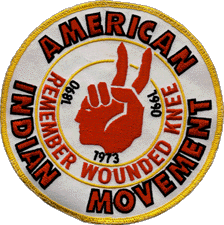
Rights and Responsibilities:
The American Indian Movement
(Aim)


A BRIEF TIMELINE OF AIM
1968-1969
Establishment of AIM:
-
Founders- Dennis Banks, NeeGawNwayWeeDun, Clyde H. Bellecourt, George Mitchell
-
Indians of the Native American community were also a part of this
-
When: 1968
-
Where: Minneapolis, Minnesota
-
What: A movement connecting the Indian people together. This movement also gave opportunity for people across the Americas and Canada and help improve their living conditions including poverty, housing, and police harassment.
"Indians of all Tribes" Occupation of Alcatraz:
-
Group of young Indians took over Alcatraz in November of 1969.
-
They issued a proclamation called the "Proclamation of the Great White Father" which stated Alcatraz was fit for an Indian Reservation.
-
They thought it should be converted into an Indian education and cultural center.
-
They continued to occupy the island until June of 1971.
-
the Alcatraz Occupation greatly influenced the American government's decision to abolish its policy of Termination and Relocation and to pass the Indian Self-Determination and Education Assistance Act of 1975.

1975-1978
Federation of Survivor Schools:
-
This was created to provide encouragement to 16 survival schools
-
(Department of) Housing and Urban Development chose AIM to sponsor the first housing project run by Indians (Little Earth of United Tribes)
The Longest Walk:
-
Planned and organized by the American Indian Movement
-
Roughly 2,000 supporters joined this event
-
The supporters concluded a 5-month march from San Francisco to the Washington Monument at Washington D.C
-
The objective of the march was to protest against 11 bills connected to the Native Americans
-
Only about 24 people were able to survive the entire walk

1972-1973
Trail of Broken Treaties
-
Cross-country protest organized by Native Americans in the October of 1972.
-
Indians started on the west coast and made it in Washington with a caravan in November of 1972.
-
They were supposed to bring attention to Native American concerns such as treaty rights and living standards.
-
The American Indian Movement and other organizations designed the Twenty-Point Position paper.
-
The paper was written to reestablish the authority of the Indian Nations.
-
The caravan did not accomplish all of its objectives, however, a powerful statement was made concerning the rights of Native Americans.
Bureau of Indian Affairs building takeover:
-
The American Indian Movement together with 500 more American Indians took over the BIA building in Washington, D.C.
-
Caused by their need to negotiate about better housing and other issues. Siege began when an evil plan was put together as a double-cross.
-
The complainants began to vandalize the building in protest.
-
The protesters caused damages costing about $700,000 (Stuff like treaties, deeds, and records were stolen and burned)